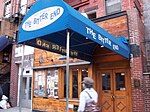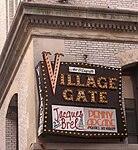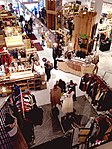Garrick Cinema

The Garrick Cinema (periodically referred to as the New Andy Warhol Garrick Theatre, Andy Warhol's Garrick Cinema, Garrick Theatre, or Nickelodeon) was a 199-seat movie house at 152 Bleecker Street in the Greenwich Village neighborhood of Lower Manhattan in New York City. Andy Warhol debuted many of his notable films (including Bike Boy (1967), Blue Movie (1969), Flesh (1968), Lonesome Cowboys (1968), Loves of Ondine (1967) and others) in this building (as well as in other area theaters, including the 55th Street Playhouse) in the late 1960s. Frank Zappa and the Mothers of Invention played here nightly for 6 months in 1967. The Cafe Au Go Go was located in the basement of the theater building in the late 1960s, and was a prominent Greenwich Village night club, featuring many well known musical groups, folksingers and comedy acts.
Excerpt from the Wikipedia article Garrick Cinema (License: CC BY-SA 3.0, Authors, Images).Garrick Cinema
Bleecker Street, New York Manhattan
Geographical coordinates (GPS) Address Nearby Places Show on map
Geographical coordinates (GPS)
| Latitude | Longitude |
|---|---|
| N 40.7282 ° | E -73.9994 ° |
Address
Bleecker Street 144
10012 New York, Manhattan
New York, United States
Open on Google Maps








